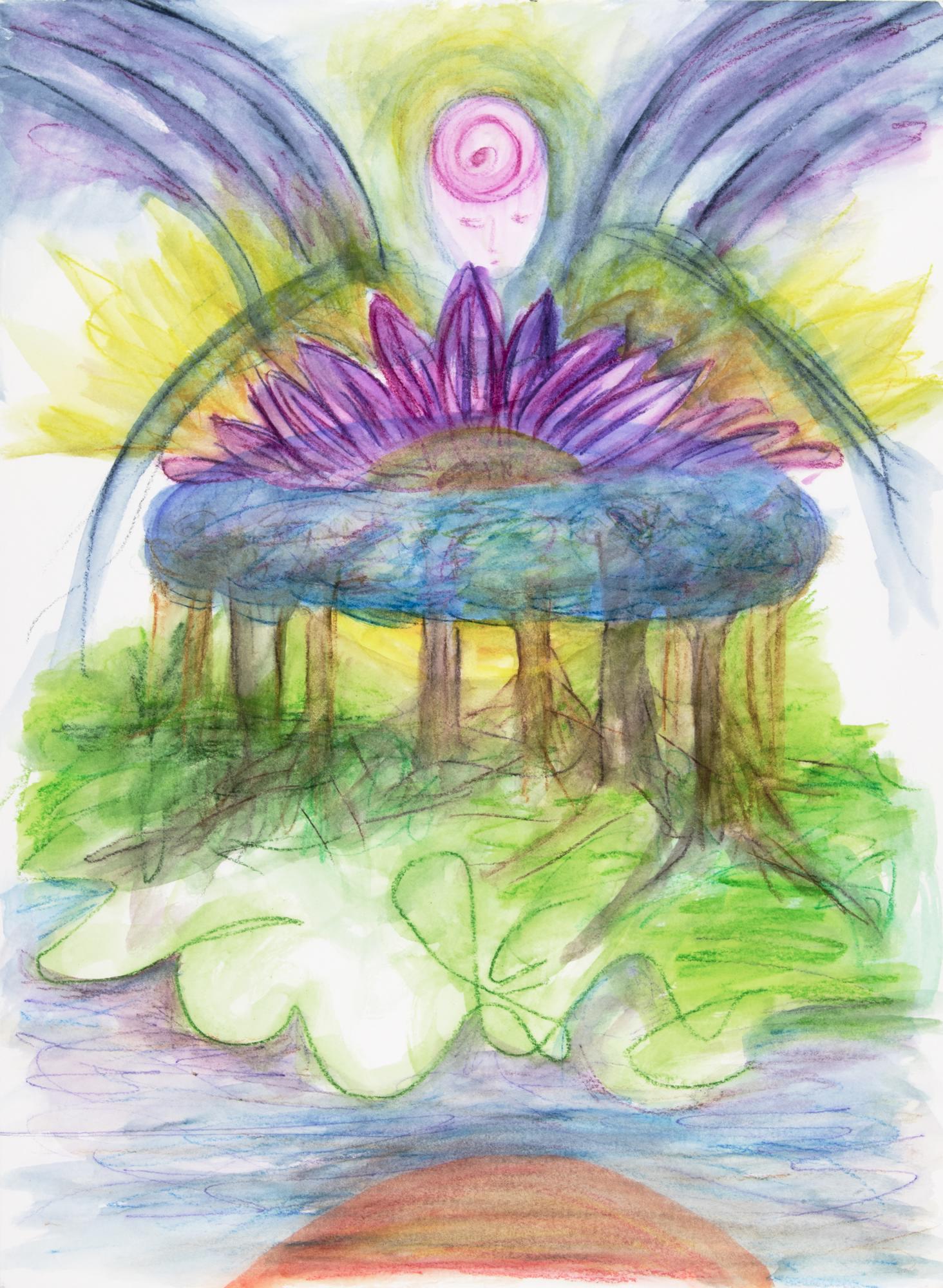How can we converse with Trees? by Elyse Pomeranz
Elyse Pomeranz creates beautiful art as a way of offering to trees the “use of her hands” to communicate. She receives the essence of the communication through “Tree Conversations.” The following is an excerpt from her “Introduction to Tree Conversation”
How do we communicate with non- human living beings? What are the “organs” we use with which we “speak” and “listen”. I am proposing, with the tree conversation work, that the heart is an organ of perception, and that Imagination is the language by which we can have conversation with nonhuman,non-verbal beings. Many of us have experienced “communicating” with animals. There are some people who are called animal “whisperers” who can “understand “ the non-verbal “language” of animals.
There is a growing body of research that describes plant communication and intelligence. This communication can be through chemistry, plant communities, infrasound etc. I am working with yet another level of communication, something like what occurs when someone comes into the room and you feel a kind of connection or perhaps revulsion, without anyone saying anything.
The way I begin a conversation with a tree is by approaching the tree with my back turned and extending my hands into the space behind my back to greet the tree. I silently and inwardly ask permission to engage in a conversation. If I sense that I am welcomed, then I will sit at the base of the tree with my back leaning against the trunk. I have been refused on a few occasions and I know that I must only do this work with full permission. After all, in any conversation, the other parties must be free to choose to participate or not. This is particularly important with a tree that does not have the freedom of movement that animals and humans have. A tree cannot move away from someone who decides to lean against their trunk or climb up into their branches.
I set up my paper and inktense pencils and enter a meditation with my eyes closed. I direct my attention into my heart space. I carry that heart attention using my “Imaginative Cognitive” activity down into the centre of the earth and back up to my heart. I experience this as a centering and grounding. I then carry my heart attention further, expanding it out towards the periphery of the cosmos, reaching and stretching as far as I can, and then I bring that attention back again into my heart space.
With an Oak in Dulwich Park, South London, England. It is the third year in a rowI I worked with this tree and two other Oaks. They are in partnership to keep in touch wiith some of the ancient impulses of the land,
Sometimes I have a question, or something is troubling me and I will bring this, imagining telling or showing the tree what I mean, then I wait for a response. Sometimes I just open myself to listen to whatever the tree will share with me. .. I find that my attention is directed to or I notice that I’m drawn to a certain colour, I sense a certain movement or form or line and I use the (Derwent Inktense) pencils to represent that to the best of my ability. I wet what I’ve drawn on the paper and let it dry, releasing the vibrant inks. I return to my meditative, receptive state. Then I am attracted to another colour. I apply that to the page and then wet. I continue this for as long as I may.
I find that if I have an hour or more then something really beautiful and complex can emerge. I still find the shorter conversations valuable. As in our daily lives we can have a powerful resonant conversation just waiting for the bus, or in passing on the street. A lot of importance can be conveyed and expressed in a short time. I would say for myself that I enjoy a nice long time of an hour or more…I suppose this is like wishing to have a couple of hours in a café with a good friend!
…
Each tree has a different outer perceptible form. The proportions, shapes of the trunk and branches, and the orientation in the landscape are unique. .. Even though trees may be of the same species/genus and thus have similarities, there is not one that is identical to another. They have different inner qualities as well. Some are patient and kind, others irritable and like to taunt or tease. Some are wise and deep while others are frivolous. Some are thrilled to make contact and others are reclusive.
These individual characteristics come into contact with my tendencies. And as with certain people, with some trees I feel completely at home, I feel welcomed and understood. I would even say, I feel loved and cherished. There are individual trees that I think about from time to time as one would a friend that lives somewhere else. There are some trees that have a grandeur, a majesty and wisdom. They carry a view that spans thousands of years into the past and into the future! The encounters with these trees are humbling and have a long lasting effect on me although I would not necessarily consider these trees as “friends”.
…I would describe The Tree Conversations as a new process of art that takes an additional step : I am active within my inner world (Imagination or what I called Imaginative Cognition) and with this activity I am seeking the equivalent inner Imaginative realm of the living world, in my case that inner world of a mature or ancient Tree. Out of this encounter I am returning to the sense perceptible world and recording an impression of the inner non- sense perceptible experience.
….I propose that there are different forms of consciousness in the animal, plant and mineral kingdoms and ways of communicating with that consciousness. The result of recognizing this is that we cannot continue to “do to” the Earth. We know, or are coming to know, that when humans “do things to” each other there can be a violent outcome. Relationship requires that we do “with” each other. We can be interested in the experience of the other. We listen. We express. We have conversation and so can find our way forward with greater insight.
The Earth is teeming with varied forms of consciousness that we can and will learn to communicate with. Trees, especially mature and/or ancient trees, seem to be particularly accessible, perhaps closest to the consciousness that we call “thinking”. Many people have experiences with trees that include finding solace, renewal, insight or inspiration….(Trees) can be companions and co-creators on the path to a restored and healed ecology. If trees are in fact “conscious” then we are obliged to work with them out of respect, valuing their contributions to the future of the Earth.
Elyse is a teacher and mentor within the Waldorf tradition, a facilitator and mediator, an artist and art therapist, writer and photographer. She has brought her art into service as a means of communication her deep connection with the natural world, in particular, with the trees. See her website www.thetreeconversations.com to read this complete article and more, to view her art, and to learn about her advocacy for trees.


